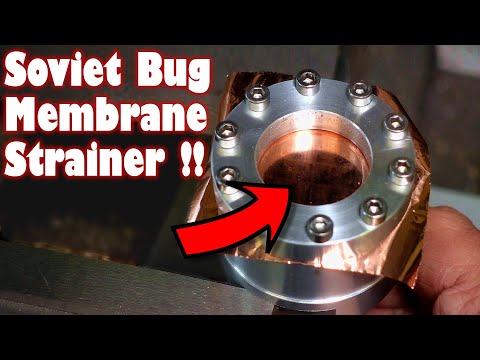Machining Metal Membrane Strainers for a Secret Project!

i need to stretch some metallic membranes almost to the point where they rupture they're for a special project i can't talk about yet but i am able to share how i made the membrane stretching fixture be careful with that foil it's only 10 micrometers thick that's four tenths for any imperialists in the room the tensile strength is only about 200 megapascals dagnabit muskie, foiled again i've lost count is that the seventh or eighth time you've messed it up so far as AIMEE said the foil is a copper alloy and it's about half the thickness of household aluminium baking foil i need to stretch it beyond the elastic limit so work hardens and becomes extremely flat it has to be stretched radially rather than linearly so i designed a fixture to clamp the foil over a void and then force a radiused polished stainless steel piston against the foil to stretch it in all directions at once first steps making the piston for a piece of 316 stainless bar i don't know how well it'll machine and i'm trying a new yg1 insert from cutwel that's designed specifically for good performance on stainless i didn't take a deep enough cut off the face so i'll try some more optimistic cuts to see how it behaves it's not dumping much heat into the workpiece although the chips aren't coloring up like carbon and alloy steel does i can see there's a bit of tool deflection those spirals in the machined surface are a dead giveaway taking four millimeters off the diameter it's two millimeters depth of cut seems to break good chips as long as i keep the feed rate high i'm not over impressed with the finish though it's definitely nothing like the finish i can get on 4140 and tool steel using a similar depth of cut and chip load useful data for a future application anyway oh nice chips right now i'll face off using a polished insert intended for aluminium as i know they'll give a very good finish with light cuts in stainless i need to hog out a pocket into the face of the bar so i'll drill it with some cobalt split point drills to six millimeters then 12 millimeters and then move to a 16 millimeter two flute end mill and finally a four flute 20 mm roofing end mill as expected that's a reasonably good surface finish that's a nifty sheepskin taper wiper available from all good stores i'm using the big jacobs ball bearing chuck on an mt3 taper now this next step is going to alarm some folks but it's a safety measure because i'm going to be doing something sketchy next disclaimer time do not copy what i'm doing here as it is all ill-advised i do love this comedy size center drill it must be half an inch diameter yes i know i shouldn't be using it in a drill chuck but this material isn't grabby and i've got one foot on the emergency brake the tail stock doesn't have a draw bar so even if it was in a collet chuck it could still grab the chuck out the mt3 taper well that was surprising that four flute high speed steel rooughing end mill cut the stainless very cleanly with no chatter unlike that coated two-flute job which screamed like a banshee doesn't this little 12 millimeter boring bar came from Arceurotrade it was very low cost perhaps 15 pounds it's using a ccmt060204 insert which is the usual polished and uncoated carbide for aluminium that i like now for a trick i learned from my dad when he had a scrap end mill or radius toll with one or more broken teeth he'd bring them home to use on his little lathe this is an almost new four millimeter radius cutter it should do very well as a form tool to make the smooth radius on the edge of the piston so the foil can flow over it i'm moving the tool radially and axially so that i don't get any chatter if you just try going straight in the cutting area so large that thing yells like a yelling thing i'm being extremely careful about not allowing the scotchbrite to get into a position where it could wrap around the work piece or catch on the lathe polishing fine details like this is potentially very dangerous indeed i use small pieces of abrasive tiny bits of aluminum paper or small blocks of brightboy or cratex and i stay highly aware of what's going on that's shorthand for if anyone feels the need to yell at me in capitals about how i've definitely lose body parts from doing this please don't bother trolls gonna troll off camera i reposition the tool to round over the top and inside edges and then give it another polish finishing with some extremely fine diamond paste in fact i think it's safe to say i think that'll do the piston needs an m6 threaded hole through the axis i'm going straight in with a five millimeter cobalt split point stub drill from drill service as i've got plenty of tolerance for concentricity those drills self-center really well my dad used to hand grind split points that were a work of art he was a tool and cutter grinder after all sadly it was a learned skill and not a genetic trait so i haven't inherited that ability whatever mr lamarck says fair to say you're almost as bad at grinding split points as you are at tig welding that lovely ear wax on the tap is ct-90. it's an unattractive shade of brown but sticks like a thing that doesn't come unstuck it also makes taps glide through even quite horrible material marvelous and that's my lovely starrett 93b tap wrench it's an absolute joy to use if i remember i'll put a link in the description the taps are spiral flute m6x1 it might be a Volkel the length of the piston isn't a critical dimension so i'm aligning the right edge of this 1.5 millimeter mgmn parting tool with the top of the curve then taking an extra half millimeter that i'll machine to size later so far so good i'm quite liking this 316. it's got a reputation for being a
bit tough but actually it's machining beautifully right then it's fixture time i'm making a mandrel from brass facing it then fitting an m6 thread for the piston to screw onto so that i can machine the back flat that's an m5 stub drill for the m6 thread i drilled and tapped the hole rather deeper than strictly necessary of fitting a short grub screw or set screw down the hole to act as a stop for a longer grub screw i could have jammed a bolt in and then sawed the end off and machined it to length but the box of stainless grubs was nearby luckily concentricity is not important because i'm only making the back flat if i'd done this properly i would have single pointed a thread on the end of the solid bar well i think that passes muster it'll get a final polish before it's actually used but i think that's nearly good enough i'd be really grateful if you could click the like button it makes the youtube algorithm ever so happy and then it'll show this video to loads more people this is my splendid chuck stop from edge technology link's in the description the parallels are able to move a little to ensure they're flush with the chuck face i like it because it's quick to deploy and doesn't need any changes to the chuck this part is going to be the clamping ring that holds the foil membrane down we start by facing it off for no historical or cultural reason at all is that better it's time for a huge apology for the next 39 seconds of blurry video my inability to operate a camera is legendary the focus was probably fine for anything buried 30 feet below the floor i can't reshoot the footage but if i miss it out there's a gap in the story anyway that's the body and clamp ring surfaced and faced next step's to clean the faces with acetone and use little high viscosity ca glue or super glue if you prefer to fix the clamp ring to the body so i can machine them and ensure they remain concentric what are the chances neil's thumb will be glued to the work piece where are your nitrile gloves well the cap is a bit wobbly but there's more than enough material needs removing the seam's almost invisible i like the way the glue doesn't run and drip like some ca glue does i've lost count of the number of pairs of jeans that i've ruined that's a decent finish as well now i need to drill and bore out the center of the body and hope the cap stays glued in place fingers crossed well actually not makes it very hard to operate the lathe i'm taking easy steps up to 11.5 millimeter drill and then i'll use a 12 millimeter machine reamer to finish the rear bore. ominous foreboding as quinn would intone at this point the front part of the body and the ring need opening up to about 35 millimeters but although my confidence in that glue line is rising i'm still going in steps 17 milli first then 20 and then 25. that 25 millimeter drill does look a bit brutal for that small part and it's singing a bit too much for my liking but it's sharp and it's removing 2.5 millimeters per side without breaking the glue line also i've got excellent 3m ear defenders hashtag not sponsored i'm not going to risk using my giant drills i've already used up my entire store of good luck with that 25 millimeter so i'll remove the rest of the stock using a boring bar with the same ccmt060204 insert that i used on the stainless piston the tolerance on this hole doesn't justify the use of my spi 25 to 30 three point bore mic but i'm doing some tests of tool deflection against feed rate depth of cut and spindle speed in my never-ending quest to hit the dimension of every part i make smack in the middle of the tolerance range so any excuse to gather a bit more data it also means i can check the calibration of the ancient 1980s new all digital readout on my equally ancient lathe the dro uses a lot of ttl chips doesn't have a processor and it's very analog it's still going strong after 40 years if you don't know what ttl is try asking a techie who was born in the 50s the hole needs a proper chamfer on it rather than just deburring so that the piston will drop straight in this new wall uses original spherosyn scales which are a marvel of old tech working rather like a linear variable differential transformer but using a stack of precisely machined ball bearings measuring the phase difference between an incident and an induced oscillation damn clever stuff i'm leaving the ring glued to the body so i can drill the bolt circle in one set up for the ten tapped and clearance holes spoiler alert close your eyes and count to five if you don't want to see into the future you didn't really close your eyes did you safe to open them now anyway this little part screws into the piston and acts as a pusher and a rough alignment bearing it needs an m6 thread on top to fit into the piston thread i'm not single pointing it as it's not a high tolerance part the split dial do fine a quick check to make sure everything fits and then we can part it off now it's time to put the dimple in the end of the push rod and make all the other parts but that'll be in part two which will be up there quite soon oh i love cliffhangers
2022-06-03 17:29


